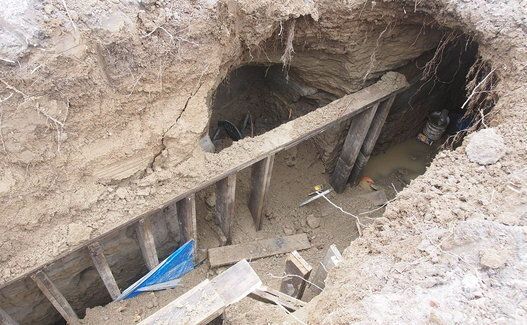Toronto Police say they have no idea why someone built an underground bunker near a Pan Am Games site or who dug it.
Deputy Chief Mark Saunders said a conservation officer discovered a mound of dirt in a densely forested area on Jan. 14, well off the beaten path. He then found a piece of wood that covered a 10-foot hole in the ground, with a ladder leading to a chamber. He immediately contacted police, who have been investigating for the past month but are no closer to finding out who is behind it.
“It’s not your everyday find,” Saunders said.
“My concern is I don’t know why this is here, and it can go one way or the other way.”
He said it looks like the tunnel took a long time to build and was probably used at some point this winter. It was found just south of York University near the Rexall Centre, which will be used as a venue during this summer's Pan Am Games. However, he added that he does not believe the discovery poses a risk to the games.
A rosary and a Remembrance Day poppy were found inside the bunker, along with a sump pump, moisture-proof light bulbs, a wheelbarrow and food and beverage containers.
“The individuals responsible for building it clearly had some level of expertise in ensuring its structural integrity,” Saunders said.
The bunker was 6’4" high and 33 feet long, and its walls and ceiling were reinforced with plywood.
“There’s nothing that suggests this is a criminal [act] in any way shape or form.”
“There’s no criminal offence for digging a hole,” Saunders said. However, police added that the act could violate local bylaws.
Story continues below
Police have since filled in the hole. Saunders said there is another smaller hole a short distance away that had a gas generator and a concealed extension cord.
Reporters at the press conference asked Saunders why police didn't carry out surveillance of the area to try to identify who built the bunker. The deputy police chief said the force did not wait longer to watch the area because some media were already aware of its existence and police “wanted to get in front of" the story.
Toronto police spokesman Victor Kwong later confirmed that police did conduct surveillance of the area before deciding to fill in the hole for public safety reasons.
Saunders also added that the hole was likely built by more than one person using shovels, and it didn't appear machines were used.
Police released a series of pictures, including one of the generator, a Honda Kodiak model SX02800HX, and another of a Mastercraft compressor.
The evidence is currently being examined by a forensic team, Kwong told HuffPost Canada. Tracing serial numbers on the equipment and looking for fingerprints on evidence are standard procedure, he said.
The serial number on the generator can help police identify the store where it was purchased, Kwong said. But it's harder to identify the person who bought it since the serial number of a product is not typically recorded at the checkout. Specialty stores that sell professional equipment are more likely to record serial numbers, but the generator found at the scene is not a high-grade model.
As for fingerprints, the standard dust won’t work because of the dirt at the scene so police have turned to chemical processes that can help identify fingerprints.
Kwong said police have already received many calls from members of the public speculating on the structure of the tunnel and offering tips.
